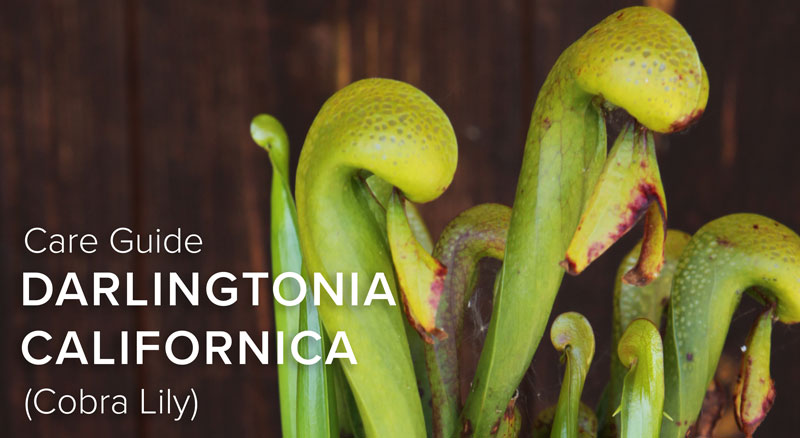
Darlingtonia Californica is an easy and rewarding plant to grow but will struggle if it is not in the right place.
Grow in pots (preferably brown or white rather than black to prevent too much root warming) in water trays or saucers in a cold greenhouse or outside.
Darlingtonia does not like having its root grow cooked during a hot summer. So do not stand the plant in a hot conservatory or on hot patios. If grown undercover, keep the plant near the entrance so it is in the coolest position. Darlingtonia will grow up to 75cm tall and prefers a sheltered position if grown outside. We have one colonising well in a large bog garden.
Watering
Always use soft water, preferably rainwater. We keep ours standing in 2-4cm water from March through October and then damp through the winter. If other root cooling measures are taken, there is no need to pour iced water through the pot. We have never used iced water.
Feeding
Never give any fertiliser through the root system. If the plant is grown in fly-free conditions, it is best to feed live insects into the trap during the growing season. You can obtain Live wax worms and meal worms from http://www.globallivefood.com. They often get indigestion in the summer when they quickly catch many insects. Indigestion causes a brown patch, which is a good sign of a healthy plant. However, it is difficult to avoid without blocking up the entrance to the trap with cotton wool.
Winter Care
We have had large mature plants outside over winter, down to -13C and have had reports from a customer in the midlands who have had them survive -19C! Small plants and seedlings are not so hardy and should over winter in a cold greenhouse, cloche or cold windowsill. Remove old foliage as it dies down, primarily if grown under cover as dead leaves can harbour botrytis. However, this is more common in Sarracenias. Darlingtonia must have a cold winter so that it stops growing and has a rest.
Compost
We use a mixture of 6:2:1 Sphagnum peat: perlite: sharp lime-free sand—parts by volume. Darlingtonia will also grow well in pure live sphagnum moss. Re-pot every two years to achieve maximum growth, but will tolerate being left for four years.
Propagation
Separation of young stolons from around the edge of the parent plant. Division of the main plant. It can also be grown from seed. Sow immediately after harvesting or in very early spring.
Pest and Disease
Watch out for aphids (greenfly). Look on young developing growth, especially early spring growth, as they will cause severe distortion or loss of the fangs. Spray with a soft soap or a systemic insecticide, as per instructions on the bottle. Always spray in the early morning or evening. Thrips are tiny blackish insects that cause speckling and silvering on the foliage. You may need a hand lens to see it. Spray with a soft soap or a systemic insecticide. Mealybugs are found deep in the leaf axils or on leaf ribs. They are a small white fluffy mass with a pale pink insect within the wool. Very damaging and will weaken the plant. Spray a systemic insecticide, or dab each insect with a paintbrush dipped in meths or alcohol.
